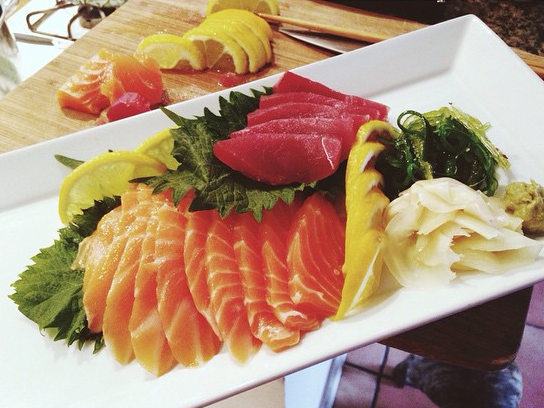Do It Yourself Sashimi
Recipe by Amy Tran
Sashimi is a popular Japanese dish of thin slices of raw fish. It is not only delicious, but also a great source of lean protein. It is also packed with good amounts of Omega-3 fatty acids, phosphorous, magnesium, and vitamins B6 and B12. It is a popular choice at Japanese Sushi restaurants, and is also conveniently Paleo friendly!
If you’re like me, you may love going out to eat sushi or sashimi, but your wallet doesn’t. Sashimi is expensive, and to be honest, the portions are very small and I am often left still feeling hungry. Preparing sashimi on your own not only saves you money, but you are also able to get a lot more bang or “fish” for your buck. As long as you have a sharp knife, and decent knife skills, fresh sashimi can be at your fingertips.
Why Do It Yourself?
Simple – it saves you money, and you get more food!
Going out to get sashimi can be really expensive. Just two weekends ago, I went out and got a sashimi plate in Pacific Beach that included nine slices of very thin assorted pieces of fish for $20 a plate. My boyfriend and I each got an order of this, totaling to $40 before tax and tip, and we were still hungry.
Comparing prices with DIY sashimi is extremely cost efficient. By recommendation from Coach Calvin Sun, I stopped by Nijiya Market, and I spent roughly $40 and got enough sashimi grade tuna and salmon to make three generous plates of sashimi, and also enough to make some tuna poke as well. We were stuffed!
What You Need to Know
It’s fast and easy! No cooking is required. The great thing about sashimi is you eat it raw! No hassle of heating anything up and waiting for it to cook; all you have to do is keep it properly chilled, and slice when you’re ready to eat it. Instant gratification.
Where to Buy and What to Look For
You can go to any Japanese grocery store; here in San Diego, we have Nijiya Market, Mitsuwa Marketplace, and Marukai Corporation to name a few.
-Fish labeled “sashimi grade”, this ensures that it is fresh and of high quality; intended to be eaten raw.
-Fish that has been cleaned, trimmed, and deboned.
-Fish that is packed on the same day.
-Fish that, if you light press into the flesh, there is no indentation and the fish bounces back.
*Some popular choices include (but not limited to); salmon, tuna, yellow tail, shrimp, and mackerel.
How to Slice and What to Serve it with
Using a sharp knife, with the base of your knife leading the cut, slice along the grain down towards yourself in one long singular motion (DO NOT saw back and forth through the fish).
Create thin slices between ¼ inch and ½ and inch thick, depending on your liking. I did my salmon about ¼ inch thick at an angle, and I sliced my tuna thicker at about ½ inch slices.
We dipped our sashimi in little bowls of coconut aminos and wasabi, and served it alongside with seaweed salad. For a healthy, delicious seaweed salad recipe, try this quick recipe by Coach Michele: M’s Sugarless Seaweed Salad.
Enjoy!
